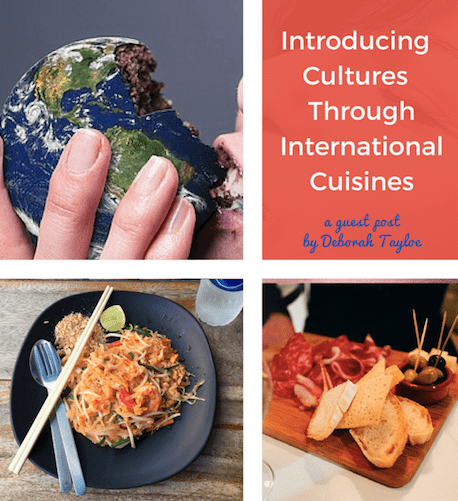Dumpling Day! A Celebration of 10 Delicious Dumplings From Around the World
Dumplings, little hot pockets of goodness, are made by wrapping dough around a filling.
The dough, filling, shape, and cooking method can be different based on the country or culture they are from, but one thing is the same: dumplings are a popular food wherever you are!
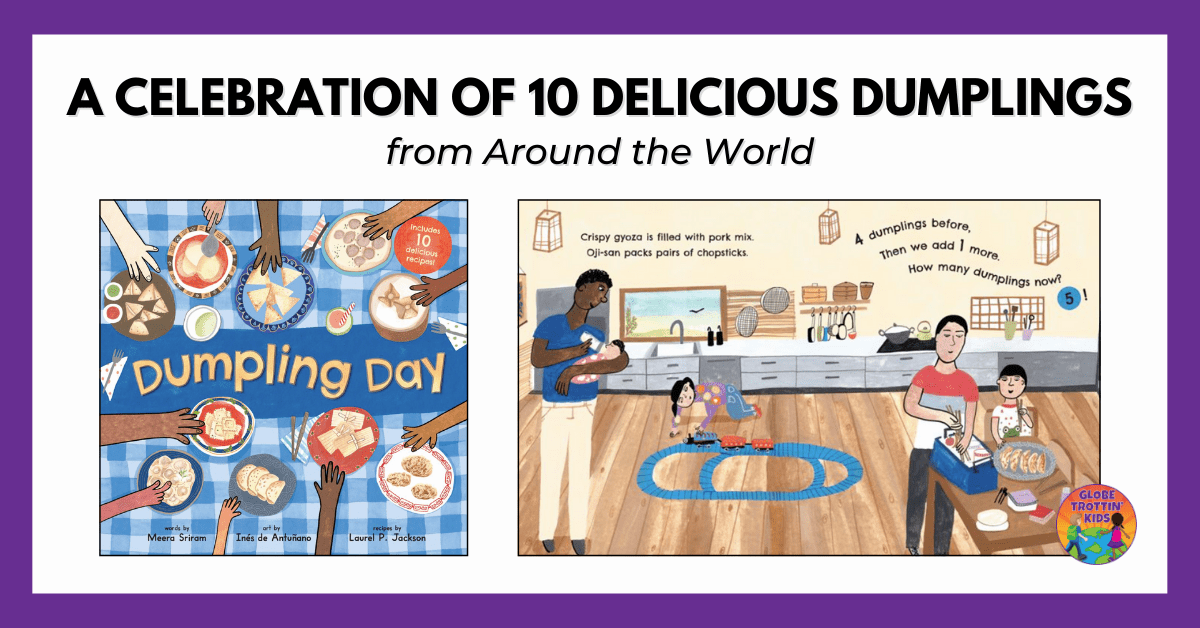
Disclosure: This post contains affiliate links. By clicking through and making a purchase, we receive a small commission at no extra charge to you. All proceeds help support our free global education website. Thank you!
Dumpling Day! A Celebration of 10 Delicious Dumplings From Around the World
Dumpling Day by Meera Sriram is a mouth-watering introduction to 10 types of dumplings from around the world.* Rhyming text and counting patterns make it an engaging book for young readers.
Authentic recipes for the 10 dumplings are included in the back of the book. Each recipe has a difficulty rating and uses ingredients commonly found in grocery stores.
*India, USA, China, Nigeria, Japan, Israel, Mexico, Syria, Russia, and Italy
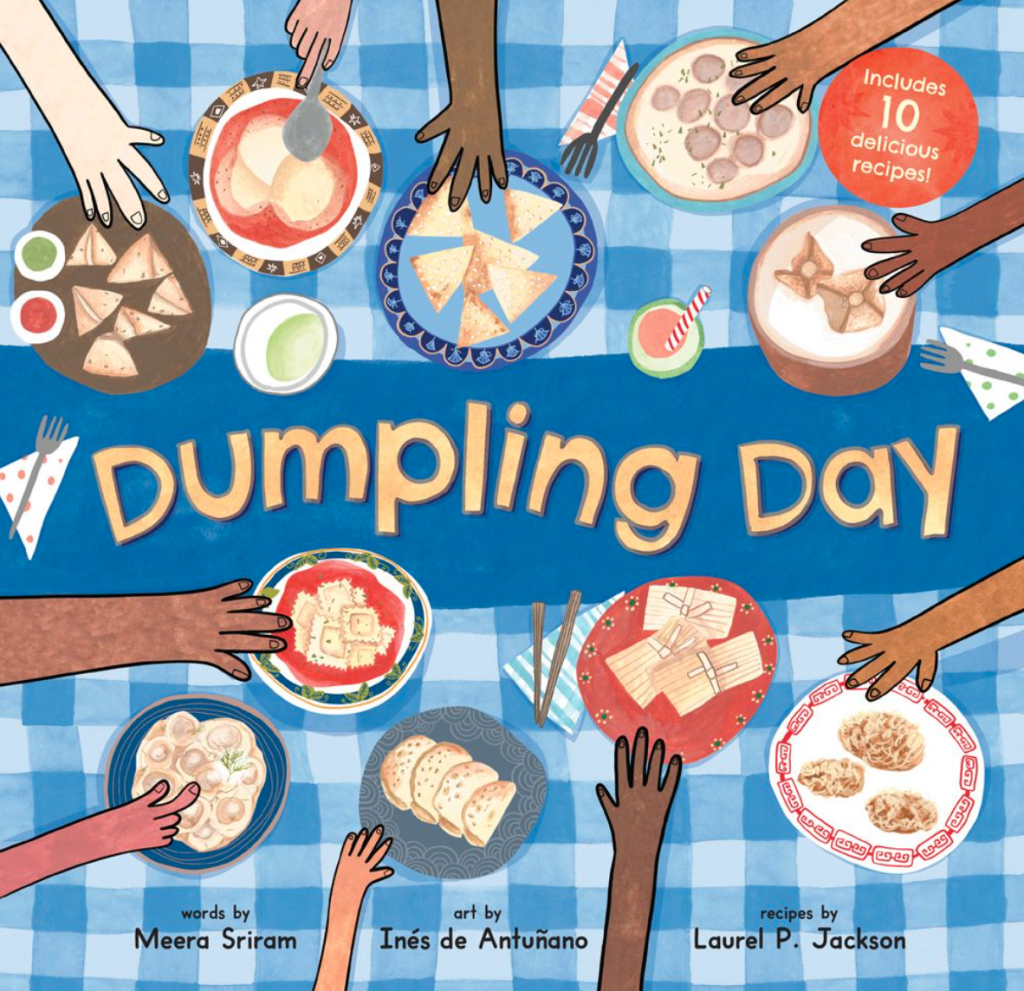
Before Reading: Dumpling Day Ready
Build Background: What is a dumpling? Have you ever eaten a dumpling? What kind? Do you recognize any of the dumplings on the cover?
Make Predictions: What do you think the story is about? Why do you believe that? (If needed, point out the word “Day” in the title, prompting a connection to other celebrations that have the word “Day” in them, like New Year’s Day, Valentine’s Day, World Animal Day, etc.) Why do you think there is a celebration of dumplings?
During Reading: Dumpling Day Discussion
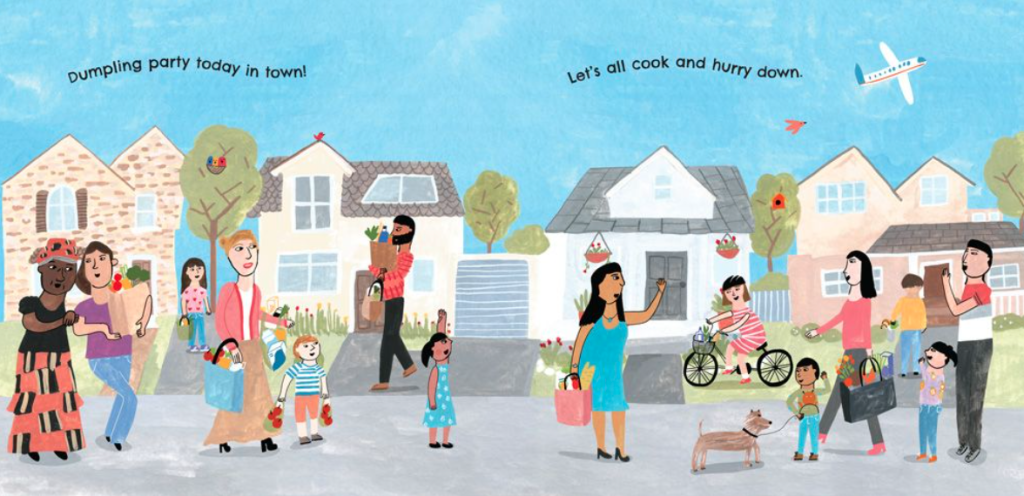
Opening Spread: What is similar about the neighbors? (carrying bags of food, flowers, everyone contributing, friendly faces and gestures). What is different? (food, clothing, skin tone, homes)
The families head to their kitchens to prepare their version of dumplings for the celebration.
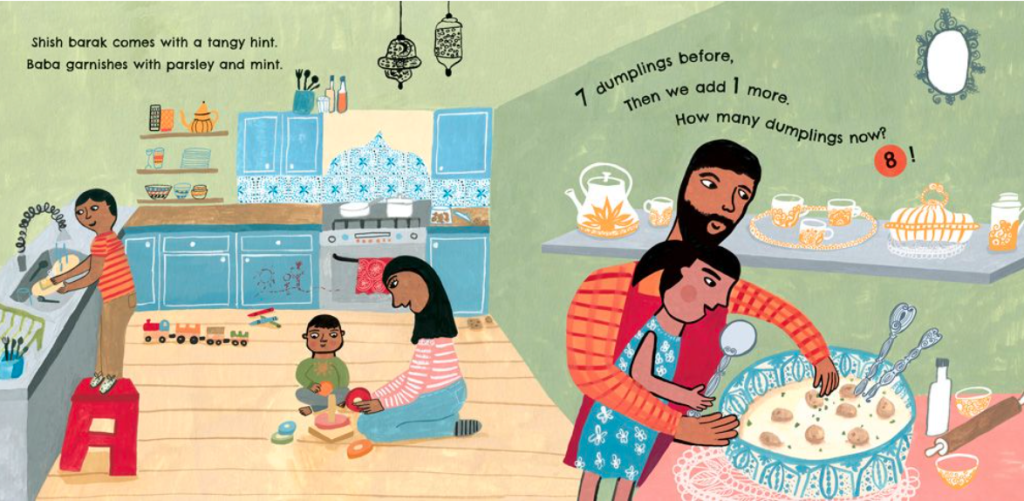
Following Spreads: Each features a type of dumpling being prepared and offers opportunities to practice various skills (during this or subsequent reading of the story).
- Rhyming Couplets – identify the pairs of rhyming words (hint, mint); brainstorm additional rhyming words (tint, lint)
- Dumplings – identify the type of dumpling (shish barak) and an adjective that describes it (tangy)
- Helpers – identify the family member’s name (Baba); predict who Baba is using text and picture clues (Example: “Baba garnishes with parsley and mint.” The illustration makes me think it’s the father.) Confirm predictions using the language dictionary at the end of the story. Baba is Arabic for “father.”
- Counting – “Then we add 1 more” is repeated each time a dumpling is added to the plate. Cover the colored number circle with your thumb or removable sticker before sharing each spread, allowing students the chance to provide the correct answer; write a number model to represent the number of dumplings now (7 + 1 = 8); identify the answers as odd or even; explain how could they be shared equally and if there would be leftovers; identify other objects in the illustration that show the number (8
- Culture & Geography – identify cultural clues in the illustrations (lanterns, wall tile) and text to predict what country or region the dumpling is from (Syria, Middle East). Confirm predictions using the world map at the end of the story.
After reading several pages, can students identify any patterns? (The first line of each couplet names the type of dumpling; the second line names the helper, like Saba, Prima, etc.; one dumpling is added each time; ends with, “How many dumplings now?”)
Encourage students to chime in with the repeating phrase on each spread:
__ dumplings before,
Then we add 1 more.
How many dumplings now? __!
After Reading: Dumpling Day Endnotes & Activities
Before sharing the endnotes (beginning on the “Let’s Make Dumplings!” page), ask students to think about the similarities of the various dumplings they just learned about and to work with a partner to come up with a definition for the word “dumpling.”
Share responses before resuming and sharing the definition from the book.
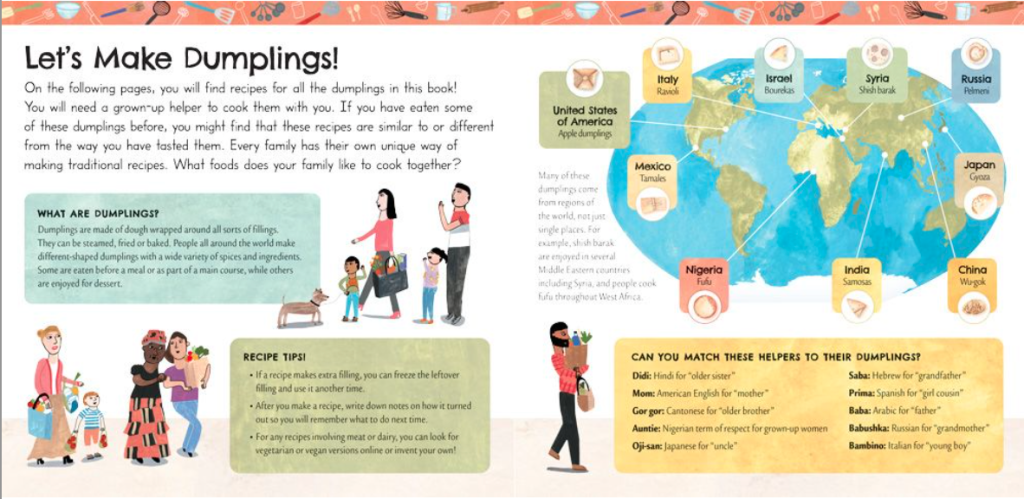
The author provides three recipe tips. Ask students to share any advice they have from their own cooking experiences.
Use the world map to review the 10 delicious dumplings and where they are enjoyed. Add some geography questions: For example, “On which continent would I find fufu? Which continent(s) are not represented in this book? If I was in Russia eating pelmeni, which direction would I need to go to get wu-gok?”
Author’s Purpose: Why do you think the author wrote this book?
Activities:
- Print 3 FREE Dumpling Recipe Cards: Samosas (India), Apple Dumplings (U.S.), & Bourekas (Israel)
- Find other types of dumplings from around the world, such as Empanadas (Spain), Spanakopita (Greece), Momo (Nepal), Knodel (Germany), Gnocchi (Italy), Mandu (Korea), and Dango (Japan).
- Pose basic addition/subtraction story problems for students to solve. For example, There are 3 samosas and 6 gyozas on a plate. How many dumplings are there in all? Before the party, there were 10 tamales on the plate. After the party, there were 4. How many tamales were eaten?
- Rewrite the story in reverse and subtract the dumplings (1 less) as they are eaten.
- Host a Dumpling Day luncheon with samples from volunteer families or local restaurants.
- Learn more about the countries represented in the story through our Country Profiles. Click on a country for a detailed map, infographic, informational video, photo gallery, learning activities, and more!
Create Your Own Dumpling Draw, label, and describe your variation of a dumpling.
- What is the dough made from? (bread, flour, potatoes)
- What is the filling? (meat, fish, cheese, vegetables, fruit, sweets)
- How will it be cooked? (steamed, fried, boiled, baked)
- What is it called?
- Where can it be found in the world?
Meet the Dumpling Day Team
Author Meera Sriram grew up in India and moved to the United States in 1999. She is the author of other picture books, including The Yellow Suitcase and A Gift for Amma: Market Day in India.

Signed copies of the books are available on the author’s website.
Mexican illustrator and graphic designer Inés de Antunano creates artwork with gouache on paper and digital techniques.
Recipes are by Laurel P. Jackson, a global educational consultant and passionate cook.


